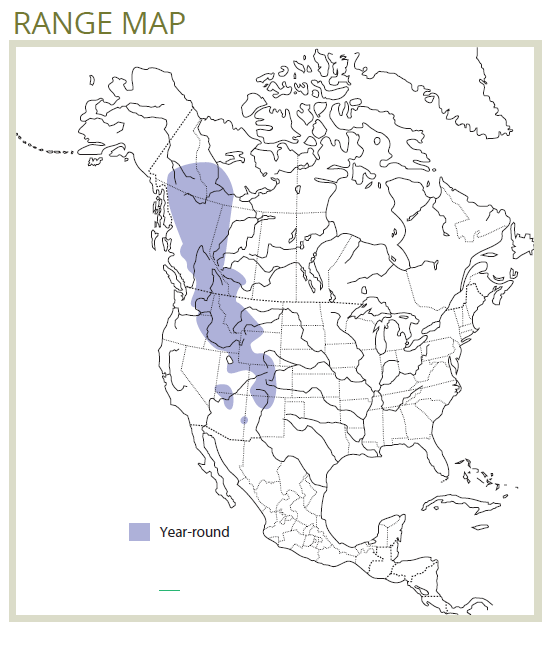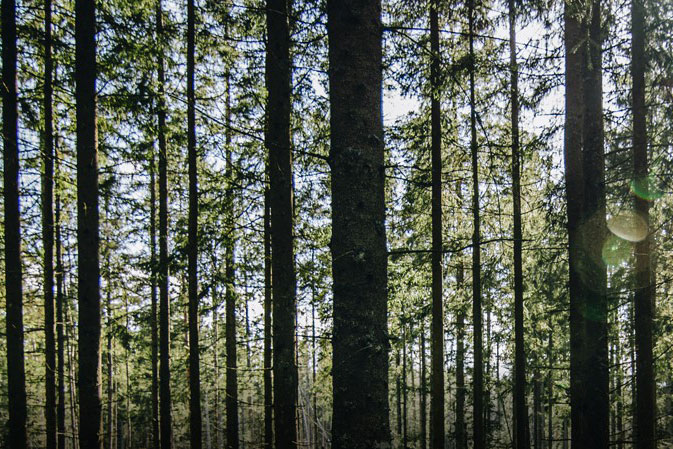The Dusky Grouse was considered a subspecies of the Blue Grouse until 2016, when it was recognized as a separate species.
Dusky Grouse
(Dendragapus obscurus)
Habitat Ecology
- Dusky Grouse occupy a range of habitats including sagebrush and grasslands. They use forest habitats including ponderosa pine, Douglas fir, and true fir. Aspen thickets are important habitat for juveniles and breeding males.1
- During the winter, this species migrates to higher elevations (up to >3,600 m) to conifer-dominated stands including Douglas fir, subalpine fir, lodgepole pine, limber pine, Engelmann spruce, and western hemlock.1,2
- Conifer needles, particularly Douglas fir needles, are an important winter food source.1
- Ground nests are built in well-developed herbaceous and shrub layers within forest openings.1 Fallen, suspended logs may increase nesting success.3

Response to Forest Management
- Responses to harvest are not well-studied or well-understood,1 however the loss of coniferous habitats and structural diversity due to harvesting are considered threats to the Dusky Grouse.4
- This species has been observed feeding on planted ponderosa pine seedlings in Idaho.5
Stand-level Recommendations
- Selective logging with retention of old (>150 years if available), large-diameter Douglas fir and clumps of mature subalpine fir and/or Engelmann spruce is recommended within wintering habitats. Recommended retention patch sizes range from 1 ha to >4 ha.4,6,7
Landscape-level Recommendations
- Heterogeneous landscapes including shrubby grasslands, open ponderosa pine with aspen groves, and Douglas fir with true fir appear to provide a range of high-quality breeding and wintering habitat.1,6
- Within Douglas fir forests on intensively managed landscapes (e.g., subject to extensive clearcutting), old (>200 year-old) Douglas fir stands should be represented.6
- Uneven-aged management that promotes structural diversity, creates forest openings, and maintains patches and stands exceeding the rotation age, as occurs in an NRV scenario or using ecosystem-based management, are likely to benefit this species throughout its range.4,7
References
- Zwickel, F. C. & Bendell, J. F. 2005. Dusky Grouse (Dendragapus obscurus), version 2.0. in The Birds of North America (Rodewald, P. G., ed.) Cornell Lab of Ornithology, Ithaca, New York, USA. Available online: https://birdsna.org/Species-Account/bna/species/dusgro
- Pekins, P. J., Lindzey, F. G. & Gessaman, J. A. 1991. Physical Characteristics of Blue Grouse Winter-Use Trees and Roost Sites. Great Basin Naturalist 51: 244–248.
- Pelren, E. C. & Crawford, J. A. 1999. Blue Grouse nesting parameters and habitat associations in northeastern Oregon. Great Basin Naturalist 59: 368–373. Available online: https://scholarsarchive.byu.edu/cgi/viewcontent.cgi?referer=https://www….
- Environment Canada. 2013. Bird Conservation Strategy for Bird Conservation Region 9 Pacific and Yukon Region: Great Basin. Canadian Wildlife Service, Environment Canada, Delta, British Columbia. 105 pages + appendices.
- Curtis, J. D. & Elder, F. S. 1965. Blue grouse feeding on planted ponderosa pine. Journal of Wildlife Management 29: 199–200.
- Remington, T. E. & Hoffman, R. W. 1996. Food habits and preferences of blue grouse during winter. The Journal of Wildlife Management 60: 808–817. Available online: http://www.jstor.org/stable/3802381
- Environment Canada. 2013. Bird Conservation Strategy for Bird Conservation Region 10 in Pacific and Yukon Region – Northern Rockies. Canadian Wildlife Service, Environment Canada, Delta, British Columbia. 109 pages + appendices.








